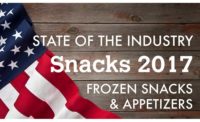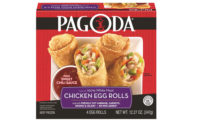Frozen foods and snacks are meeting no shortage of challenges in the marketplace according to the “Frozen Foods in the U.S.: Hot Meals, Sides, and Snacks” report from Packaged Facts. First, as the report points out, there is unprecedented consumer demand for fresh products—or, at least, fresher products—in refrigerated rather than frozen form. Plus, frozen foods often contain preservatives such as potassium sorbate, calcium propionate and sodium tripolyphosphate, which are at odds with clean-label and natural trends driving the food industry as a whole. Finally, previously popular low-calorie and diet-oriented frozen foods are facing additional consumer scrutiny as a result of their high sodium contents.
Add to this the fact that frozen foods face a sort of antiquated reputation, and it becomes clear that there’s a bit of rebranding that needs to be done in order for this sector to succeed. “Many consumers have come to believe that only fresh foods offer real nutritional value,” says David Sprinkle, research director, Packaged Facts, Rockville, MD. He adds that the strong anti-frozen viewpoint on the part of these shoppers can even blind them to brands whose products offer the same nutritional value as fresh or refrigerated options.
But it’s not just judgment in the frozen aisle stunting growth, reveals the report. It’s also about what’s happening in other areas of the store. Packaged Facts points out that there are more and more sources, such as farmers markets and expanded produce sections in grocery and big box stores, offering fresh produce and other foods. In short, these additional sources are pulling consumers away from the freezer case.
“In the last couple of years we have seen a decline in frozen foods,” says Agnes Lapinska, marketing manager, savory, Ingredion Inc., Westchester, IL. “Consumers are changing their shopping patterns and, as a result, the landscape of retail is changing. We have seen a significant consumer migration from the center and frozen aisles to the perimeter of the store, where products are perceived as fresher and better for you.”
Data from IRI, Chicago, shows relatively flat sales in the frozen appetizers and snack rolls category. In the 52 weeks ending April 17, 2016, the category grew just 1.95 percent in dollar sales to reach $2.1 billion. Within that segment, which includes frozen appetizers/snack rolls, frozen breaded vegetables, and frozen soft pretzels, the bright spot was frozen appetizers and snack rolls—the largest segment of the category by far—up 2.34 percent in dollar sales to $2.0 billion. Standout companies in this market included Schwan Food Co. and its Pagoda brand frozen appetizers (up 453.25 percent in dollar sales to $50.5 million), which include various egg rolls, crab Rangoon, wontons and potstickers, as well as Nestlé’s Hot Pockets brand snack rolls (up 1,378.77 percent to $30.0 million).
Frozen pretzels took a dip in sales, posting a 2.49 percent decline, reaching $74.5 million in sales. But a bright spot was gluten-free pretzels from Tonya’s Gluten Free Kitchen (up 33.18 percent) and organic options from Rudi’s Organic Bakery (up 235.09 percent).
Snack producers would be wise to take note: This organic and gluten-free trend buoying soft pretzels is one that will help carry the frozen foods category going forward. Also, the moves Schwan Food Co. and Nestlé have made to improve product quality, add ethnic appeal and draw interest from millennial consumers have proven profitable.
Packaged Facts says the silver lining in the category lies with frozen foods that identify as natural or organic, as they provide a health or freshness halo. The best news of all? Packaged Facts estimates that the frozen food category as a whole has the potential to grow to $23 billion, and that frozen appetizers and snacks are poised to lead the way and garner the most growth in years ahead.
Clean and fresh
Many frozen snack brands are capitalizing on better-for-you consumer demands, rather than trying to compete with them, by offering products that take a clean-label approach.
Indeed, everyone from niche brands to large international companies are looking to feature clean and recognizable ingredients in their frozen offerings, according to Jennifer Stephens, vice president of marketing at Fiberstar, River Falls, WI. “Due to the growing group of label readers, companies are looking to use more recognizable ingredients (ingredients found in the kitchen), shorter ingredient declarations and a more home-style look and feel,” she says.
But this can be a challenge, Stephens notes, since “artificial” ingredients can often be the workhorses that manage water in a formulation—an important aspect of developing a stable frozen food. “Natural ingredients have limitations when subjected to harsh processing and storage conditions, such as freezing,” she adds. “Therefore, manufacturers are on a quest to balance food quality and shelf life when striving for natural appeal.”
Fiberstar recently launched a new non-GMO Citri-Fi citrus fiber to fit into clean-label formulation strategies. The ingredient appeals to clean-label formulators because it can be labeled as “citrus fiber,” “dried citrus pulp” or “citrus flour,” and it works in gluten-free products as a natural emulsifier. “Since many gluten-free baked goods producers store their products in the freezer case to extend shelf life,” says Stephens, “Citri-Fi also provides moisture management control in these products, due to its high surface area which lends itself to the high water-holding capacity.”
According to Lapinska, brand transformation to appeal to freshness is a leading trend. “They start with the feel and look of the product packaging, and move to claims and updating their ingredients,” she says. “The idea behind this movement is to create new products that resonate with today’s consumer needs while increasing the perception of freshness.”
Ingredion launched NOVATION PRIMA 340 functional native starch in May, which offers instant viscosity and high stability under cold temperature storage for baked or fried frozen meals and snacks, frozen desserts, and frozen filled snacks, like egg rolls and taquitos.
Angelina De Castro, senior manager of marketing, wholesome ingredients, Ingredion, says that formulators replacing instant modified food starches with this new ingredient can benefit from clean-label, non-GMO and gluten-free claims.
Building more culinary appeal into the freezer case can also help. “The frozen food market is currently at an inflection point,” says Vanessa Phillips, CEO, Feel Good Foods, Brooklyn, NY. “While companies are having to invest in educating the consumer, we believe the old stigma of 1980s microwave dinners, associated with frozen foods, is changing. Companies like Feel Good Foods are working at changing the way people view frozen foods, proving that chef-inspired dishes can be in the frozen aisle of the supermarket.”
And, what do “chef-inspired” foods offer? Spice and flavor—a trend taking the frozen market by storm, Phillips adds. When paired with better-for-you claims, ethnic foods have seen a huge spike. And that’s exactly what Feel Good Foods offers: gluten-free egg rolls, dumplings and other Asian-inspired cuisine. “Consumers want to enjoy bold flavors, but with the convenience of quick preparation time,” she says.
Indeed, spice sells. Among frozen taquitos, El Monterey branded offerings from Ruiz Food Products, Inc., Dinuba, CA, were a top seller, according to IRI, growing 8.60 percent in dollar sales to reach $191.0 million in sales. “Both heat and spice have been a trend in the frozen Mexican foods category for quite some time,” explains Rachel P. Cullen, president and CEO. “Today’s consumer enjoys experimenting with a variety of flavors and spices.”
The future of frozen
The future of this category can be a bright one if brands can focus on offering the right products to the right consumers.
Consumer research from Ingredion shows that perception is king. “Consumers look at everything about the product when determining its perceived freshness, including location, shelf life, ingredient label and visual cues,” says Lapinska. In the freezer section, she sees an opportunity for brands to repackage their offerings with fresh-friendly language and marketing. “Offer a modern and enticing look and feel, state the product benefits, and reformulate for a cleaner, simpler label,” she advises. “Clean labels are a part of how consumers perceive freshness, along with authentic and exciting flavors.”
Targeting the right consumers will also matter, says Phillips, who identifies the younger generation as a perceptive audience for clean-label frozen offerings.
Millennials are also a key driver for Ruiz Food Products, says Cullen. For any frozen, heat-and-eat snack, convenience is instrumental to success. But millennials seek more from their foods.
“With the millennials coming through, the importance of nutrition, non-GMO, clean label and local sourcing is going to reinforce the need for new frozen baked good and snack lines,” says Stephens.
Branching out into a more-youthful demographic also shows promise, perhaps because millennials are beginning to start families, and are searching for kid-friendly foods that meet their discerning criteria. “Cleaning up the labels and improving the nutritional profiles, without losing the sense of appeal, could be an opportunity in the kids segment,” says Stephens. “There are new companies popping up run by mothers, creating products tailored to toddlers and small children. Many of these products can be found in the freezer case.”
Small plates, big trend
According to data from Technomic, Chicago, frozen foods are poised to capitalize on restaurant trends.
In the past three years, there has been a surge in menu options when it comes to pretzels (up 14.7 percent), flatbreads (up 12.3 percent), pizza (up 6.4 percent) and cheese/pizza bread (up 1.8 percent). This may have something to do with the fact that small plates are as popular as ever, with 74 percent of the top operators offering appetizers and small plates at an average of seven items per operator. Indeed, small plates are the true superstar, since appetizer offerings in terms of number of menu items were slightly down; small plate menu items (per establishment) soared 80 percent since 2013, per Technomic.
Dishes labeled as “small plates” have increased over 550 percent overall since 2013, appealing to happy hour, drink-pairing, and snacking trends. Why? Technomic reports that 42 percent of consumers want more small plates, and about half of consumers say that ordering small plates helps them control their portion sizes, save money and share dishes with a group.








